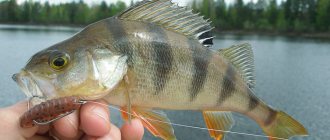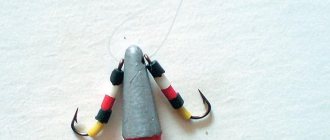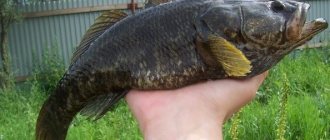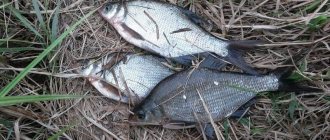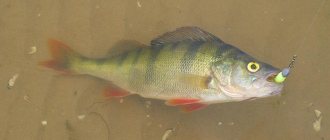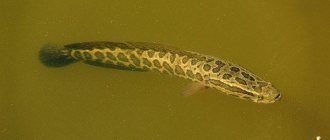Yuri 12/22/2020 73
The predatory fish, perch, is not known for being cautious or picky, so you can catch it not only with a spinning rod, but also with a simple fishing rod with a float. But for successful fishing with this gear, the absence of wind and current is important, and it is unlikely that you will be able to boast of a large catch with this method of fishing. To catch larger fish even in strong winds and currents, anglers use a perch bottom, which also allows you to cast much further from the shore.
Features of catching perch on a donk
Content
Perch is often caught using live bait due to its versatility. Donka fishing has its own characteristics in comparison with other methods of hunting. Only taking into account the peculiarities of tactics, the characteristics of the reservoir, and the method of fishing, is it possible to get the desired trophy.
Perch is a predator and tends to attack various live baits. Small fish with bright scales or leeches should attract the perch and provoke a sharp attack from the float. It is better to catch live bait in the selected reservoir; small roach, gudgeon and bleak are suitable for this role. To extend the life of live bait, you should thread it with a hook through the nostril and bring the point out through the lower lip.
There are many types of bottom tackle, but experienced fishermen often call the jig the best. The selection of jigs is carried out individually, but in conditions of good visibility in the water it is better to use dim varieties of jigs, and in opaque water shiny, bright specimens perform well.
Any bottom fishing rod, the hooks of which are equipped with animal baits, can be considered set for catching perch
It is important to consider the following features when fishing for perch:
- Donk fishing is often done from a boat; the key difference from shore fishing is the need to use a rod about 0.5 m long. It is even better to install an inertial reel instead of a spinning reel;
- It is not necessary to use live bait and bait; pieces of fresh fish and crayfish are allowed;
- It is worth remembering that fishing with live bait requires lengthening the leash. A carabiner and a leash made of fishing line with a diameter of 0.25 mm are attached to the main line at a distance of 40 cm from the sinker;
- Bottom fishing is effective in water depths of 3 m or more;
- large perch are more willing to attack moving baits. We recommend animating the bait by moving the tip of the fishing rod. The game of bait can greatly increase the attractiveness of the bait.
Read more
What is a donka for pike?
Tackle for catching perch on donka
We will need simple bottom tackle; now there is no need for complex equipment:
- The main line is taken with a cross-section of 0.2-0.3 mm. We select the length taking into account the fishing method and the remoteness of the promising location;
- hooks Numbers 4-8 are most often attached to the leash. If there are a lot of useless bites - there are either cautious or small fish, it is better to use smaller hook options - No. 12. Half a worm is used as bait;
- sinker. They are installed on a separate leash, the weight is selected so that the tackle stays well in one place. The length of the leash is taken to be small - 20-40 cm;
- rod It is better to take one with a flexible tip, which allows you to detect small bites.
If during float fishing a worm is actively used as a bait, then it is better to use larger baits on the bottom, ideally a gudgeon, but any small fish will do. Catching perch on a bottom with live bait often brings large and medium-sized specimens, since small specimens hunt exclusively for fry.

Purposefully catching perch on a donk makes sense in cases where you can hope for bites from large representatives of these fish
Live bait tackle
Today, perch is caught with a wide variety of gear, and some gear is more suitable for catching perch in the winter, and some in the summer, or in autumn and spring. Also, the gear will depend on which body of water to catch perch on.
When fishing on ponds, lakes, oxbow lakes, small rivers, where small perch are mainly found, they are caught using ordinary float rods, spinning rods, bottom tackle, and much more. The main requirements for all gear for catching perch are lightness, compactness, and good strength.
At the same time, for catching perches, you should not select fishing line options that are larger than 0.1 millimeters.
If you catch perch on larger lakes and reservoirs, large rivers, then you need to take a little more powerful gear; to catch large specimens of perch, you can already take a fishing line somewhat thicker than 0.1 millimeters.
Nowadays, more and more anglers use spinning rods to catch almost all types of fish, and perch is no exception. To catch perch with a spinning rod, you need to choose a rod whose upper test will be 10-12 grams.
Some fishermen prefer an ultralight rod in the region of 6-7 grams according to the test. In terms of length, you should not take too long ones; short options are also suitable for winter fishing.
Experienced fishermen advise using an inertia-free reel with dimensions of 1000-1500; excessively high power is not needed for catching lake perches, and if you are fishing on large rivers and reservoirs where there are large-sized perches, you should take a larger reel.
Most anglers are inclined to believe that the best fishing line for perch is a braided line with dimensions up to 0.1 millimeters. But in winter it is better not to install wickerwork, because it stands up like a stake.

To catch small perches, it is better to take baits with sizes from 5 to seven centimeters, no more. If you catch larger perches, then you can choose more bait.
When catching perches in the current, the fishing line on the bottom should be thicker. For example, a green olive is more suitable for donkey when catching perch in still waters, but it should no longer be placed on a river.
When fishing on the river, a flat weight is made that can withstand the pressure of the river current. When fishing from boats, it is better to use round sliding sinkers. When casting on the main line, leashes are attached - one or two, which should be tied higher. You can also attach the sinker to a separate leash.
To successfully catch perch among vegetation, it is better to use the following type of donkey. A piece of foam plastic is taken as a base. You will also need a piece of wood or something else that will hold the bait at half-water.
Quite often, perches are caught using live bait. In this case, they take a rod with a reel, the rod itself should not be taken too long, no more than 4-5 meters, the reel is taken without inertia.
For the float, floats of bright colors are used. Hooks with sizes of 5-8 numbers are most suitable for such fishing. You should not use hooks that are too sharp or have a long shank. The weight must be positioned so that it is approximately twenty centimeters from the float.
It is also necessary to install a leash, which will help you not to lose the equipment when biting a toothy pike. You can attach a pair of hooks - one is attached to the back of the baitfish itself, and the other to the lip.
In spring and summer, the most popular tackle for perch is a float rod. Take a regular fishing rod in the area of 4-5 meters.
The most common bait for such a fishing rod will be live bait or worms or maggots. In addition, in spring or autumn, fishermen quite often use spinning rods.
Among other things, spinning rods are used when fishing for winter perch. In spring, autumn and summer, donka is also a fairly common tackle for catching perch.
In the pre-winter period, fishermen quite often use hooks or gear with sliding rigs.
Tips for beginners
- Perch is a very smart fish; it sees and hears very well.
- The perch can quickly attack the bait and swallow it; here the angler should not yawn and needs to hook.
- A fishing rod or spinning rod for catching perch should not be too heavy.
- Most often, perches can be caught in the immediate vicinity of coastal vegetation, near trees fallen into the water, where perches set up an ambush and wait for their prey.
In advance we thank everyone who showed a desire to help the site Administration in development!!
Perch is most often caught either with a spinning rod or using float gear. But there are often situations when fishing when neither one nor the other method works.
Float fishing for perch can be hampered by strong winds, or the location of the fish - long distances, as well as strong currents make fishing with float tackle impossible. With spinning the situation is a little different.
In some reservoirs, perch flatly refuses to take artificial baits, but reacts well to a worm or live bait. In such situations, catching perch on a donk helps out, because such gear allows you to fish at a great distance from the shore, in strong winds, and in strong currents.
Such fishing also implies the possibility of using bait, which can significantly increase the catch, however, it should be borne in mind that the composition of the mixtures differs from the options used for catching peaceful fish.
And here's what you need to know: Squid and cuttlefish as bait for fish in the Mediterranean Sea, where to get it, store it, how to plant it,
Rod and reel for bass fishing
Photo 1. Donka assembled.
Donka for catching perch involves using any available fishing rod that can provide a sufficient casting distance for the equipment. You can use both feeder fishing rods and spinning rods with a test suitable for the sinker, but inexpensive Chinese telescopic fiberglass spinning rods have gained the most popularity as rods.
Having a short transport length, as well as a significant margin of safety, such rods are convenient both for delivery to a reservoir and for landing trophy fish. The length of the fishing rod must be selected based on the size of the reservoir and the distance to the fishing point - the greater the distance, the longer the length of the form is appropriate.
It is best to use an inexpensive inertia-free reel as a reel in such gear. Even cheap models are easy to use, and do not create beards when using a fishing line of sufficient diameter (thin fishing lines, and especially small-diameter cords, are usually installed extremely poorly by such “meat grinders”).
The most popular reel sizes for donkeys are from 2000 to 4000, since the rods used are rarely very long. However, it should be borne in mind that many cheap models of inertia-free models are not intended for use with cords, since they do not have a coating that protects against abrasive effects.
Perch fishing is carried out using different gear. To choose the right fishing rod, you need to take into account the seasonal preferences of the fish. This dependence is presented quite clearly in the table.
Catching perch with a spinning rod is quite exciting and varied. Depending on the conditions of the reservoir, you can use different artificial baits, equipment and wiring methods. A perch spinning rod may look like this.
- A rod for fishing from a boat and from a clean shore is selected with a length of 2.1-2.4 m and a casting weight of up to 10 g. For long casts and jig fishing at great depths, a “stick” with a length of 2.7-3.0 m and a test load is required 5-20 g.
- It is best to equip a spinning rod with a spinning reel with a 1500-2000 spool.
- Jig fishing involves the use of braid, and when fishing with spoons or wobblers, monofilament fishing line 0.20-0.25 mm is also suitable.
The wiring is selected taking into account the time of year and the bait used.
Perch fishing can be successful if the bait is correctly matched to the gear used. In addition, it must be suitable for the given season of the year. The optimal combination of these factors can be seen in the table.
Which spinning rod is best to choose in terms of length will depend on the fishing method (shore or boat) and casting distance. Typically, the size of a spinning rod ranges from 1.8 m (boat) to 2.4-3 (shore). For catching perch, light or ultra-light rods with fast and ultra-fast action are used.
- Fishing with minnow wobblers at a depth of more than 2.5 m - rod test 3-14 g.
- Fishing with microjig or micro-oscillators at a depth of up to 2 m - rod test 3-10 g.
- Jig fishing at great depths - rod test up to 30 g.
Monk line measuring 0.25-0.3 mm or braided line with a breaking load of 2.5-3 kg. Monka gives better bites due to its elasticity, which prevents fish from leaving. At the same time, braided wire is good for jerking and has greater sensitivity. A fluorocarbon leash with a diameter of 0.2-0.3 mm and a length of 30-50 cm. A small inertia-free spinning reel with a spool size of 1500-2500.
There are many baits for catching perch; their choice depends on the fishing conditions. The most common and popular baits are spinners or spinners.
Rotating spoons are convenient for fishing in shallow water, and also when you need to fish different layers of water in search of perch. In cloudy weather, it is better to use spinners with fluorescent-colored petals, and in bright sunlight, use spinners painted in dull colors.
A big plus is the presence of a edge on the hook and bright dots on the petals.
The spinner is less effective and cannot be used in shallow water; deep-water areas with snags are more suitable for it. By color you can use pink, green, yellow, red.
If perch fishing is carried out at a great distance from the shore on a spit or edge strewn with snags, then various jig baits are used. When the perch is frolicking on the surface, small cranks and poppers are used. If the perch is at half-water, then you can’t do without a minnow wobbler with medium depth, a spannerbait or a basebait.
When fishing in spring and summer at shallow depths with spinners, spoons, wobblers, spinnerbaits or silicone, uniform fishing gives good results. When fishing at a depth of more than 2.5 m, especially in autumn, step-by-step fishing is used; front-loaded spinners, spoons and jigs are suitable for it
. The pause during retrieving should be 3-8 seconds; usually retrieving resumes immediately after the bait touches the bottom. When twitching the wobbler (jerk wiring), the pause for cold water is 8-9 sec., for warm water 1-4 sec.
When fishing with a popper, the retrieve must be carried out so that the bait jumps out of the water and makes characteristic sounds along with fountains of splashes.
The choice of rod for float fishing depends on the place where perch fishing takes place. If this is coastal fishing in shallow water in windows of vegetation or at its edge at a distance of up to 10 m from the shore, then a light fly rod 6-9 m long, with a fast action and a test from 2 - 15 g is suitable.
Often in such places (especially on small rivers and stakes) large perch is rarely found, so the equipment of such a fishing rod is quite thin: line 0.16-0.18 mm, rods 20-30 cm long and 0.14-0.16 mm thick .
Float with blind equipment: for standing water 2 g. for a current of 6-10 degrees.
In cases of fishing with live bait, the float must have a carrying capacity that does not allow the bait to drag it under water, and the live bait itself must be very small, no more than 3 cm. Hook No. 5-7 with a long shank.
The reel is not used at all or the small reel is used only for storing fishing line.
For fishing at a further distance from the shore, on the river bed or in pits, it is better to use light match or Bolognese rods 3-5 m long, fast action, when fishing from a boat 2-3 m. Here there is a high probability of catching a large perch, and the pike perch may turn up, so the fishing line is taken 0.25-0.3 mm, habits 0.22-0.25 mm, hooks No. 6-8.
Inertia-free reel with spool size 1500-2000. When fishing at a fishing depth of more than 2 meters, the installation of the float should be sliding.
And here's what you need to know: Catching catfish from a boat with live bait video
Perch fishing video
Fishing for perch with float tackle gives good results if you use bait from small fractions, this will lure medium-sized white fish, which in turn will interest the perch. If there is no bait, you can use pieces of bread. The perch bites sharply, the float quickly moves to the side or instantly goes under water.
The habitats of this fish depend on the age, type of reservoir and time of year. In summer, average individuals prefer to stay in creeks with abundant aquatic vegetation, which they use as shelter.
In April, before the upcoming spawning, all the perches gather in huge schools. In May, large flocks break up into smaller ones and occupy certain places on the reservoir, which they usually do not leave until the onset of autumn.
Time and place for catching perch on a donk
Perch tend to lead a school life, so when you get a bite in one area, it makes sense to re-cast the gear. Usually there are 10-15 individuals in one flock. The striped predator mainly goes for bait; the right mixture will ensure successful fishing, but it does not have any special preferences when it comes to places.
It is easiest to find fish during the summer fishing season, as they reveal their location by splashes on the water that appear during the hunt. It is easy to identify a promising area by the formation of a cauldron of fry - in the center there is a predator. The predator tends to make characteristic sounds that are not characteristic of any other underwater inhabitant. In summer, the fish stay in shallow water, close to vegetation or riffles, as there is a lot of prey here.
When planning the time period and place for fishing, you should consider:
- small individuals always stay close to the shore, first near plants (in summer), and in autumn they prefer open areas. Large ones live in the depths, leaving it only during feeding;
- in still water, the perch stands near deep-growing plants near clean areas of water, as well as in areas with weak currents near shelters;
- the predator is caught throughout the day, and the only exception is at night;
- The best chance of catching fish comes on a cool, clear day in the early morning or around sunset. These periods are the predator's hunting time.
Read more
What is a rubber shock absorber for fishing and how to use it?
In the warm season, the same fishing rules apply, but in winter the bite changes.
Winter fishing begins 10-20 days after freeze-up. The predator also gathers in flocks of 5-7 individuals, spreading throughout the entire reservoir in search of deep holes. It is advisable to fish in winter in calm weather without strong temperature fluctuations. It is better to fish at temperatures from -10 ° C to -20 ° C during the day or evening.
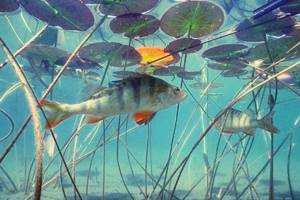
Striped predators spend a significant part of their time in the lower layer of water
Where to fish and at what time
In the summer, it is very easy to find a place with a school of perch - it gives itself away by splashing and hunting for fry - it happens that it almost jumps onto the shore, accelerating after the fry. In summer, perch is always in shallow water where there is vegetation or shade from trees, because... In such places, young peaceful fish like to hide.
Read: How to invite a perch to your place for the New Year - we hunt with a jig
In autumn, perch goes deeper and is located near bottom holes and washouts. It is usually caught early in the morning or late at night.
Donkey bait for perch
Not many baits can be combined with donka:
- perch on the bottom using live bait is the most promising equipment;
- worms (dung, earthworms);
- chopped pieces of fish.
When choosing live bait or cutting fish for bait, you should choose the right size. Excessively large live bait will be unattractive to perch, because the size of the predator is not always large. Most often they are caught with perch, gudgeon, bleak, small gobies and pieces of carp or crucian carp. Live baitfish perform better. It is important to lengthen the leash; this will allow the fish not to feel the tension of the line when testing the bait.
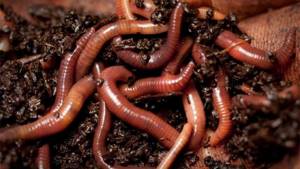
The variety of baits for catching perch is relatively small
Feeding methods
The need to feed predators always causes controversy; some use bait, while others immediately abandon the gear. If you decide to feed the perch, then crushed worms, bloodworms or maggots are added to the mixture. Additional ingredients depend on the bait delivery method. You can cast to nearby areas by hand, but first make balls of soil, clay and protein bait. If you don’t want to throw bait, use a slingshot.
There is another method of fishing, which differs in the type of bait. Some professionals use a dusty mixture that attracts peaceful fish. A predator will inevitably come to the accumulation of prey.
To feed a distant point, feeders are used; their design is created specifically for delivering animal components, most often maggots, to the fishing site. The case contains small holes and a cover. The bait is placed through the removable lid, and through small pores it gradually dissolves. Live worms are placed in such a mixture, which gradually emerge from the lump and attract a predator for a long time.
Techniques and tactics of catching perch using bottom tackle
The primary task when catching perch on a bottom from the shore is the correct choice of fishing spot. Casting should be done on edges, exits from holes and places on the bottom where there are a lot of shells. The listed places are important because they do not allow the current to erode the bait along the entire bottom and inhibit the spread of the bait.
Read more
Catching perch on a retractable leash
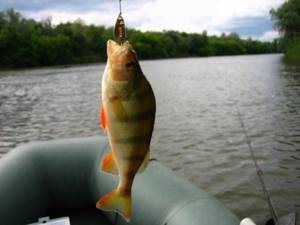
First of all, you need to decide on the fishing point
To understand the type and topography of the bottom, use a special sinker or feeder (without leashes with hooks). The fisherman pulls the load along the bottom, listening to the change in tension. After finding the place, they feed it and throw in the tackle.
Important! You should not make regular recasts, as the sound of a falling feeder causes concern even in timid fish, and it also shortens the lifespan of live bait.
If the bite is bad, it is better to add chopped worms to the hook and bait mixture, which emit a strong odor that attracts predators. The smell of worms can attract perches at a distance of up to 20-50 m. Another way to revive bites is to drag the feeder along the bottom at a slow pace, but here a sliding sinker works better, increasing the sensitivity of the gear.
Bait options and tactics for feeding the fishing point
Feeding predatory fish is a controversial issue. Many fishermen, when catching perch with donks, do not use any bait at all, considering it unnecessary. However, there are also many supporters of complementary feeding. For this purpose, cut red dung, or an earthworm, maggot or bloodworm is most often used. There are several ways to deliver animal bait to the fishing point, and the choice of feeding method depends primarily on the fishing distance. If the point that the angler plans to feed is located near the coastline, then they usually make balls of clay or soil, placing cut worms inside (this increases the smell, and therefore the attractiveness of such bait). Such balls are delivered to the fishing spot either by throwing them by hand or by shooting them with a slingshot.
Important! Some fishermen consider it advisable to use fine-grained dusty baits for peaceful fish. Such bait will collect a lot of small fish on the bottom, and sooner or later predators should also catch up to such an accumulation of prey.
To feed a point located at a considerable distance from the shore, you will have to use specially designed feeders, which are designed specifically for the delivery of animal components (primarily maggots). Their body has small holes, as well as a lid that closes after placing bait of animal origin inside. Worms come out of such a feeder relatively slowly, attracting the perch to the fishing point for a long time.
